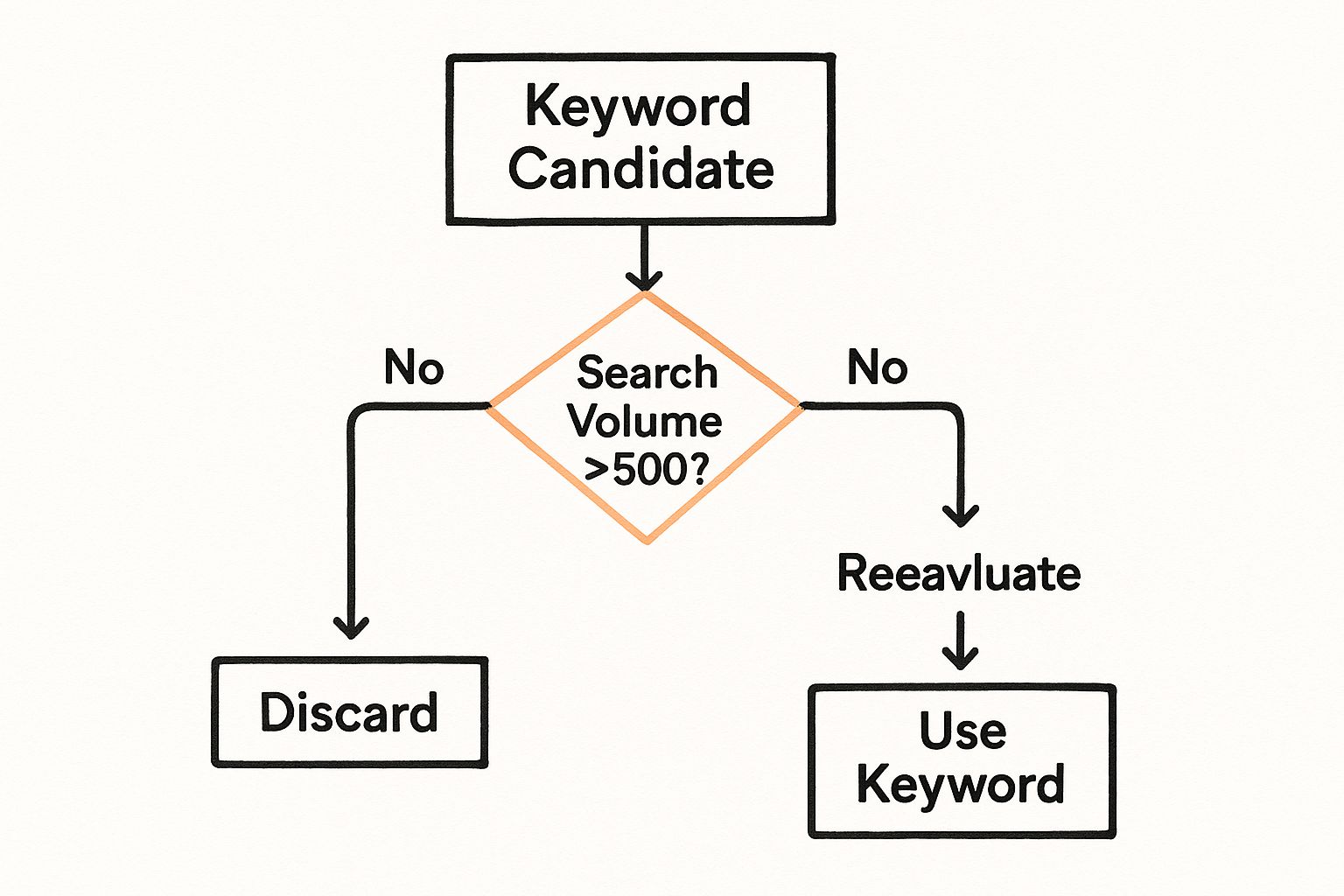Mastering Amazon KDP Keywords for More Sales

Let's get one thing straight before we jump into the nitty-gritty: your Amazon KDP keywords are the secret handshake between your book and its ideal reader. They're not just a box to tick in your KDP dashboard; they are the very lifeblood of your book's discoverability.
Why Your Keywords Can Make or Break Your Book
Think about it from a reader's perspective. They open up Amazon, ready to find their next great read. How do they find your book among the millions of others? They search. Your keywords are the signposts that cut through the noise and point them directly to your book's page.
If you don't have a smart keyword strategy, your masterpiece might as well be invisible. The Amazon A9 algorithm—the brain behind its search engine—depends almost entirely on your keywords to figure out what your book is about and who it’s for. And it’s not just looking at those seven backend keyword slots; it’s scanning your title and subtitle for clues, too.
Get Specific to Get Sales
Let's say you've written a fantastic mystery novel. Just using a general keyword like "thriller" is a decent start, but you're now competing with hundreds of thousands of other books. It’s like trying to get noticed in the middle of Times Square.
Now, what if you used something far more specific, like "psychological thriller with a strong female lead"?
A reader typing that into the search bar has a very clear idea of what they want. When your book pops up, it feels like a perfect match, and that "aha!" moment is what turns a browser into a buyer. This is how you stop guessing and start building a real, sustainable income from your writing.
The single most important skill you can develop for your keyword strategy is learning to think like a reader. What words would they actually type into the search bar to find a book exactly like yours?
How Amazon Puts Your Keywords to Work
Amazon KDP gives you space for up to seven keywords or keyphrases to describe your book. This data, combined with your sales history and Best Sellers Rank, is crucial for how high you appear in search results. A pro tip is to string words together into logical phrases—the kind a real person would search for—and test them on Amazon yourself to see what comes up.
You can dive deeper into Amazon's official keyword guidelines on their help page, but the core idea is simple.
Amazon’s own advice stresses combining words into phrases and not wasting precious space by repeating words that are already in your title or subtitle. Every single character counts.
Before we move on to the "how-to," let’s quickly recap the fundamental ideas that will shape your entire keyword research process. These concepts are the bedrock of a strategy that gets results.
Core Keyword Concepts and Their Impact
| Concept | Why It Matters for Sales | Actionable Tip |
|---|---|---|
| Reader Intent | Matching what a reader is actively searching for leads to higher click-through rates and better conversion. | Brainstorm phrases your ideal reader would type. Think problems, characters, and settings. |
| Niche Specificity | Broad terms have massive competition. Niche terms attract ready-to-buy readers looking for exactly your book. | Target 3-4 word phrases instead of single words. "Cozy cat mystery" beats "mystery." |
| Search Algorithm | Amazon's A9 algorithm uses keywords in your title, subtitle, and backend slots to rank your book. | Don't repeat keywords from your title in the backend slots. Use that space for fresh terms. |
| Long-Tail Keywords | Highly specific, multi-word phrases have lower search volume but much higher purchase intent. | Focus on phrases like "sci-fi romance with military hero" for a targeted audience. |
Getting a handle on these ideas isn't just theory—it's the difference between a book that languishes in obscurity and one that consistently finds its audience and generates sales.
Finding Your First Keywords Manually

You don't need to shell out for a bunch of expensive tools to find winning Amazon KDP keywords. Honestly, one of the most effective research methods is completely free—it just costs you a bit of time. It all begins by going straight to the source: the Amazon search bar itself.
Getting your hands dirty with this kind of manual research builds an intuition for the market that you just can't get from a spreadsheet. When you manually dig for keywords, you develop a real gut feeling for the competitive landscape. This keyword research, combined with analyzing comparable titles, is key to understanding how readers actually think and search for books like yours.
The Alphabet Soup Method
There's a reason the "Alphabet Soup" technique is a classic in the self-publishing world. It’s simple, free, and uses Amazon’s own autocomplete feature to show you what real readers are typing into that search box.
First, make sure you're in the Kindle Store on Amazon. This is important—you want results for books, not blenders. Now, type in your main book idea or a broad keyword. Let's say you've written a gritty sci-fi space opera. You might start with "space opera."
Here comes the "soup" part. After your phrase, type a space and then the letter "a". Just wait a second. Amazon will drop down a list of popular searches, like "space opera alien romance" or "space opera adventure."
Pro Tip: I always keep a simple spreadsheet or even just a text file open on the side. As you see promising phrases, copy and paste them over. Don't analyze them yet—the goal here is just to collect a big, raw list.
You’re going to do this for every single letter of the alphabet. Type "space opera b," see what pops up, then "space opera c," and so on. You’ll be surprised how quickly you can build a massive list of potential keywords, all straight from the source.
Sizing Up the Competition in the Search Results
Having a list of phrases is great, but that's just the start. The real work begins when you start plugging those keywords back into Amazon to see what comes up.
That first page of search results is a goldmine. For each promising keyword, take a hard look at the books that show up. I always check for a few key things:
- Book Covers: Are they gorgeous and professional, or do they look like someone's nephew designed them in five minutes? Polished covers usually mean you're looking at a competitive niche.
- Titles & Subtitles: Are the top-ranking books using your exact keyword in their title or subtitle? That’s a dead giveaway that they’re actively targeting that phrase.
- Best Sellers Rank (BSR): A lower BSR (closer to #1) means a book is selling well. If the top results for a keyword all have strong BSRs (say, under 20,000), you know there’s money to be made with that keyword.
This process is all about decoding what readers want without having access to Amazon’s official data. It takes a bit of elbow grease, but this method is priceless for understanding the lay of the land, especially when you're new to a genre.
Reverse-Engineering the Bestsellers
Here’s another powerful manual trick: play detective with the bestsellers in your niche. Find a handful of books that are killing it—the ones that are similar to what you've written or are planning to write.
Now, tear their book pages apart. Read their titles, subtitles, and especially their book descriptions. Are there specific phrases or terms they keep using to talk about their plot, characters, or subgenre? Those aren't there by accident. Those are almost certainly some of the keywords driving their sales. Add every single one of them to your master list for investigation.
Using Tools for a Competitive Edge

Manual research gives you a fantastic feel for the market, no doubt about it. But if you want to move from being just another author to a serious publisher, you need to bring in the heavy hitters: specialized keyword tools. This is where you graduate from intuition to data-backed strategy.
These tools are your secret weapon. They let you peek behind Amazon’s curtain and see the actual numbers driving sales. This way, you can validate your hunches and uncover those profitable Amazon KDP keywords that your competition is flying right past.
What the Numbers Really Mean
The first time you fire up a keyword tool, you'll see a dashboard full of metrics. It can look intimidating, but you only need to focus on a few key data points to strike gold.
- Estimated Search Volume: This is your traffic indicator. It shows you, on average, how many people type that exact phrase into Amazon each month. More searches mean more potential readers.
- Competitor Score: Think of this as your difficulty meter, often on a scale of 1-100. A low score is what you want—it signals weaker competition and an easier path to the first page of search results.
- Average Monthly Revenue: This is the money metric. It estimates the combined monthly earnings of the books already ranking for that keyword, telling you if customers are actually buying.
Your mission is to find that perfect trifecta: a keyword with solid search volume, a low competitor score, and proof that people are spending money. That’s the sweet spot where hidden gems are found.
A classic rookie mistake is targeting huge "vanity keywords." Sure, a term like "fantasy novel" might get 50,000 searches a month, but the competition is insane. You'll get buried. A much smarter play is a long-tail keyword like "epic fantasy with dragons and magic," which might only see 500 searches. The difference? Those 500 people know exactly what they want to buy.
A Real-World Scenario
Let's say you're publishing a self-help book for women. Your gut tells you "self-love workbook for women" is a good keyword. You pop it into a research tool to see if the data agrees.
The results are in. It gets a respectable 1,200 searches per month, and the competitor score is a totally doable 42/100. The best part? The books on page one are pulling in a combined $15,000+ every month from this one keyword. Boom. In an instant, you've just confirmed your idea isn't just a hunch—it's a commercially viable product with a waiting audience.
These tools don’t just spark new ideas; they confirm that your existing ones can actually make money. If you're looking to really sharpen your process, exploring some of the Top Marketing AI Tools can give you even more sophisticated ways to pinpoint winning keywords.
Ultimately, this data-first approach transforms your keyword strategy from a game of chance into a series of calculated business decisions. You're no longer building your book's marketing on hope; you're building it on a foundation of solid proof.
How to Choose Your Final Seven Keywords
Alright, you've done the hard work. After hours of digging through Amazon and running reports with your favorite tools, you're probably staring at a spreadsheet overflowing with potential keywords. It's a good problem to have, but this is where the real strategy comes in. Now, you have to narrow it all down to just seven golden phrases.
The goal here isn't just to pick seven random "good" keywords. You need to build a smart, balanced portfolio that acts as a beacon, guiding the right readers directly to your book's page.
To get this right, you need a simple framework. Every single keyword on your list must pass through three critical filters: reader relevance, search traffic, and competition. If a keyword doesn't check all three boxes, it's out.
The Three-Point Scoring System
This isn't about complex math; it's about a clear-headed evaluation of each potential keyword.
First up, reader relevance. This is the most important, non-negotiable gut check. Go to Amazon, type in the keyword, and look at the books that pop up. Do they feel like your book? If you've written a "cozy cat mystery" but the search results are full of gritty, hard-boiled detective novels, that keyword is a dud for you. It doesn't matter how much traffic it gets—a mismatch means your clicks won't turn into sales, and that will tank your book's ranking over time.
Next, you have to look at search traffic. A super-relevant keyword is completely useless if nobody is actually searching for it. You need proof that real readers are typing this phrase into the Amazon search bar. I always aim for a healthy mix here. Some of my keywords might have thousands of monthly searches, while others might only have a few hundred. Both are valuable.
Finally, you need to size up the competition level. A massively popular keyword like "romance books" is a black hole; you'll never get seen. But a more specific, long-tail phrase like "second chance romance over 40" might have way less competition, giving your book a fighting chance to land on the first page. Your keyword tool will give you a competition score, but don't stop there. Do your own recon. Look at the Best Sellers Rank (BSR) and the quality of the covers for the books currently ranking for that term. Can you compete? Be honest with yourself.
The sweet spot is where these three things intersect. A killer keyword is hyper-relevant to your book, has enough search volume to be worthwhile, and faces competition you can realistically beat. If even one of those elements is missing, the keyword is weak.
This little decision tree is a great way to visualize how you should filter each keyword you're considering.

As you can see, a keyword has to make it past both the traffic and competition hurdles to even be in the running for one of your final seven slots.
Assembling Your Final Keyword Portfolio
Your final seven keywords shouldn't all be the same type. Think of it like building a team—you need different players with different strengths. A balanced approach is what works best.
Here's a mix I've found to be effective:
- 2-3 Broad but Achievable Keywords: These are your bigger-picture terms. Think things like "military science fiction" or "clean and wholesome romance." They pull in a lot of traffic, and while competitive, they aren't impossible to rank for over the long haul.
- 3-4 Niche Long-Tail Keywords: These are your secret weapons. They're highly specific phrases like "dystopian thriller with a medical theme" that have less traffic but attract readers who are practically begging to buy a book that fits that exact description. The conversion rate on these can be incredible.
- 1-2 "Human" Keywords: Don't forget how real people talk and search. They might not use perfect industry jargon. Instead, they search for things like "books like The Hunger Games" or "enemies to lovers slow burn." These conversational keywords are often overlooked goldmines.
Whatever you do, steer clear of rookie mistakes like keyword stuffing (e.g., "romance love story romantic love book") or using another author's name or a trademarked series title. Amazon will penalize you for that. By building a balanced, data-driven set of seven keywords, you give your book the absolute best shot at being discovered.
Thinking Beyond the Seven Keyword Slots

As you can see, every genre has its own set of popular search terms. While getting your seven backend Amazon KDP keywords right is a huge step, it’s only part of the puzzle. To really gain an edge, you need to treat your entire book listing as prime keyword real estate.
Amazon’s A9 algorithm is constantly scanning every part of your book page—your title, subtitle, and even your description—to figure out what your book is about. This is great news for us, because it means we have more opportunities to signal to Amazon (and to readers) what makes our book a perfect match for their search.
Your Subtitle is a Secret Weapon
I see so many authors overlook their subtitle. It's easily one of the most powerful, yet underused, spots for keywords. Your main title needs to be catchy and intriguing, but your subtitle is where you get down to business.
Think of it as a direct message to both the algorithm and the reader. It’s your chance to clearly state your book's genre, tropes, and core concepts—all the things you couldn't squeeze into the main title.
- Weak Subtitle: A Gripping Novel
- Strong Subtitle: A Fast-Paced Military Sci-Fi Thriller with an Alien Invasion
That second example does all the heavy lifting. It immediately tells a potential reader exactly what they're getting. More importantly, anyone searching for "military sci-fi" or "alien invasion thriller" now has a much better chance of seeing this book pop up. Diving into long-tail keyword research strategies can help you find these highly specific and valuable phrases.
Your subtitle does double duty: it feeds crucial ranking signals to Amazon's algorithm and instantly tells readers if your book is what they're looking for.
Writing a Description for Both Robots and Humans
Your book description has two very important jobs. First, it has to be compelling enough to hook a reader and make them click "Buy Now." Second, it needs to be structured in a way that helps the A9 algorithm understand your book's relevance.
This is a balancing act. The last thing you want to do is cram a bunch of keywords into your description where they don't belong—that just looks spammy. Instead, work your main keywords and a few secondary ones into the copy naturally. Use them to set the scene, describe the protagonist, or touch on the central conflict.
Successful authors live and die by their keyword research because it shows them exactly what real readers are typing into the search bar. Trends shift constantly, so keeping an eye on what's hot in genres like thriller, romance, or self-help is vital. You can discover more insights about these keyword trends on Kindlepreneur to see what's currently working.
A final tip: use simple formatting like bold text and bullet points. This breaks up your description, making it scannable for busy readers while also highlighting key terms for the algorithm. It's a simple change that makes a big difference. For more ideas on getting seen, check out our guide on 5 proven strategies to boost book discoverability for indie authors.
Common Questions About KDP Keywords
Once you've spent hours digging for keywords, you're bound to have some lingering questions. It's totally normal. Getting the hang of KDP keywords feels like learning a new skill, and a few common sticking points come up again and again. Let's walk through some of the most frequent questions I hear from authors to help you sharpen your strategy.
Should I Use Single Words or Longer Phrases?
This one's easy: you should almost always go for long-tail keyword phrases.
Think about it from a reader's perspective. Someone typing "romance" into the search bar is just browsing. But someone searching for "enemies to lovers workplace romance" is looking to buy a very specific kind of book right now. That’s the reader you want to find.
The great thing is that Amazon’s search algorithm is sophisticated. It understands the individual words within that longer phrase, so you get credit for "romance," "workplace romance," and the full, highly specific search term all at once. It’s the best of both worlds.
Is it a Good Idea to Repeat Words from My Title?
No, you definitely want to avoid this. It's probably the most common mistake I see authors make, and it's a huge waste of a valuable opportunity.
Amazon’s A9 algorithm automatically pulls every word from your book's title and subtitle into its search index. Repeating those words in your seven backend keyword slots adds zero extra search power.
Using your keyword slots for terms already in your title is like telling someone your name twice in a row. It doesn't add any new information. Use that space to give the algorithm more unique clues about your book's content.
Treat those seven slots like bonus advertising space. Fill them with synonyms, related concepts, and reader-focused search terms that you couldn't squeeze into your title.
How Often Should I Update My Keywords?
There's a sweet spot here. I recommend taking a look at your keywords every 30 to 90 days, especially if your sales or page reads have taken a nosedive and stayed there. What readers are searching for can shift over time.
But don't get trigger-happy. Every time you change your keywords, you need to give the algorithm at least a month to process the new information and for you to see any real results. If a book is selling steadily, think twice before messing with a winning formula.
If your book is struggling, however, swapping out one or two underperforming Amazon KDP keywords is a smart way to test new ideas. Keep in mind, keywords are just one part of your marketing toolkit; you can explore other promotional strategies by learning how to promote your book for a more well-rounded approach.
What Happens If I Use a Trademarked Term?
Just don't do it. Using trademarked names like "Harry Potter," another author's name, or a well-known series title in your keywords is a fast track to trouble. It’s a clear violation of Amazon's terms of service, and they take it very seriously.
The consequences can be severe, ranging from your book being blocked to having your entire KDP account terminated. Amazon's bots are surprisingly good at flagging these violations. It’s simply not worth the risk to your author career. Stick to legitimate, descriptive keywords that describe your book.
Stop wrestling with marketing and get back to writing. ManuscriptReport.com generates a comprehensive, agency-quality marketing report for your book in about 10 minutes, giving you everything from blurbs and ad copy to a full set of optimized keywords. Get your instant book marketing report today.
Related Articles

The Ultimate Affordable Book Launch Checklist: 9 Essential Steps for 2025
Complete affordable book launch checklist for 2025. Follow 9 proven steps—from budget planning to post-launch—for indie and self-published authors. Launch successfully for under $500.

How to Write Viral Book Hooks: 10 Proven Strategies for Social Media Success
Master the art of viral book hooks with 10 proven strategies, platform-specific tactics, and templates that grab attention on BookTok, Instagram, and beyond.

7 Must-Have AI Writing Tools for Authors
Discover essential AI writing tools for authors to boost creativity and streamline marketing. Learn actionable tips and explore solutions like ManuscriptReport.com.